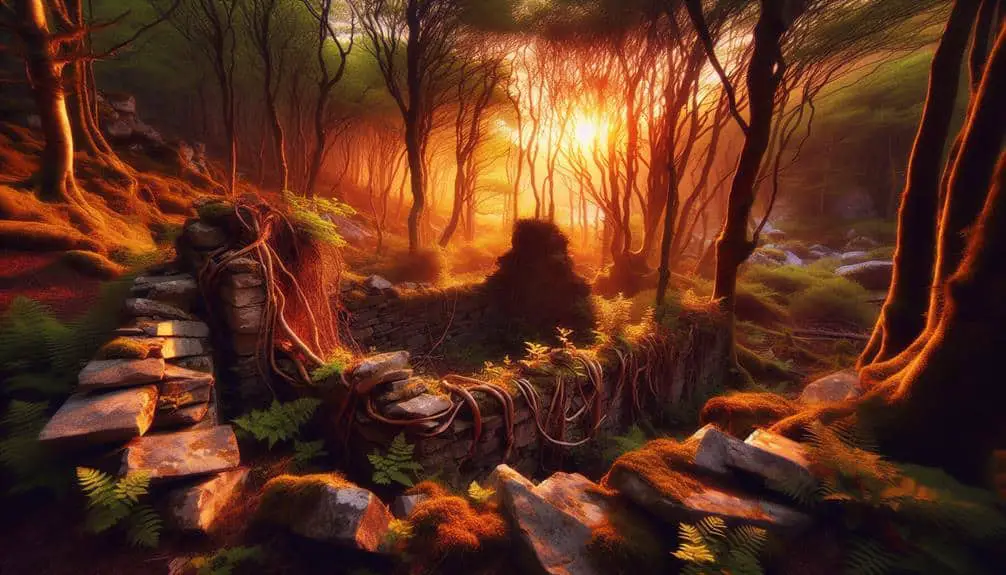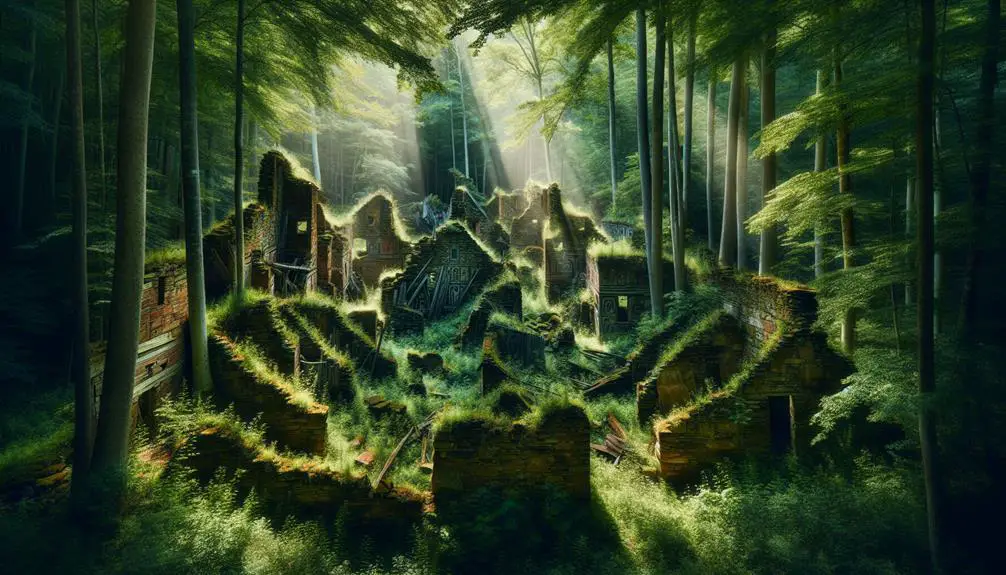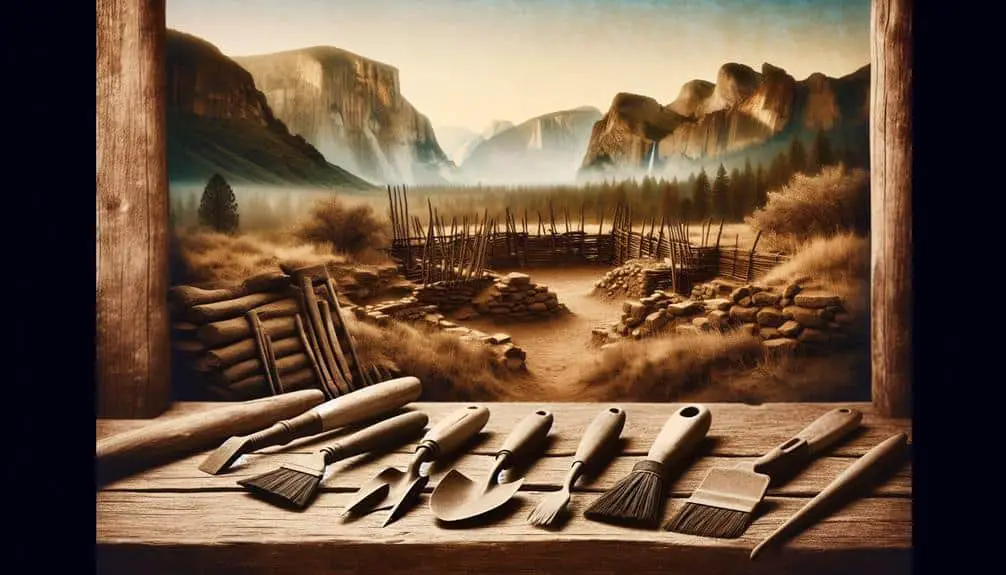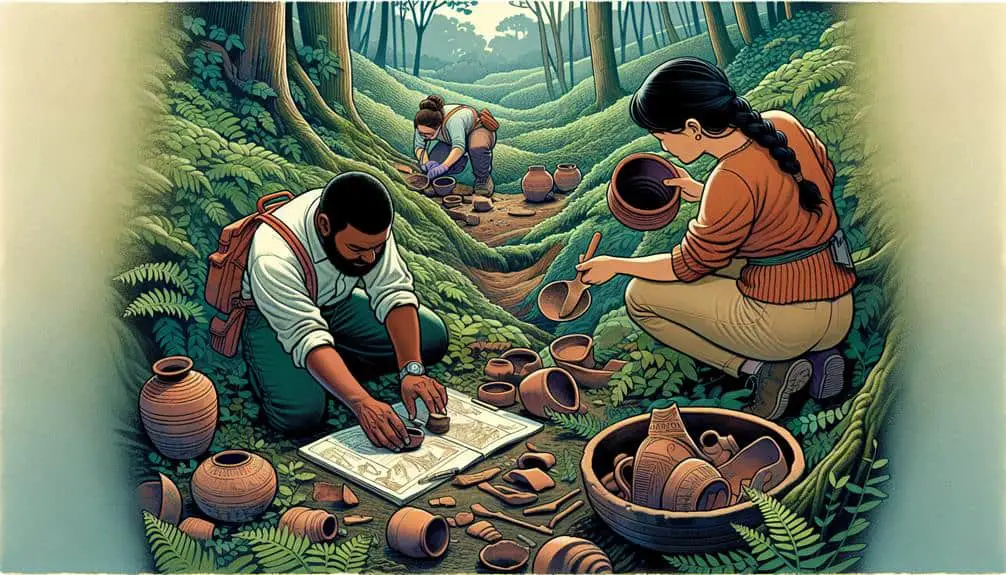Begin an expedition to uncover 10 forgotten Native American ruins across America. Cairnpapple Hill in West Lothian murmurs tales from the Neolithic past, making it a site to behold. The mounds at East Fork in St. Louis County boast a millennia-old history waiting to be explored. Step into the hidden world of Wickliffe Mounds to unravel the mysteries of ancient Indigenous cultures. Investigate shell middens at Pineland to connect with the ancestral lands of the Calusa people. Your exploration into these lesser-known ruins promises a glimpse into the rich tapestry of Native American history and architectural wonders.
Key Points
- Many forgotten Native American ruins hold historical and cultural significance.
- These ruins provide insights into ancient lives, architecture, and spiritual practices.
- Preservation efforts are crucial to safeguard these sites for future generations.
- Forgotten ruins contribute to understanding indigenous heritage and traditions.
- Exploring these sites offers a window into the rich tapestry of Native American history.
Cahokia Mounds, Illinois
The Cahokia Mounds in Illinois represent a significant archaeological site showcasing ancient Native American ruins. Their cultural significance lies in the mysteries surrounding the construction of these mounds. The ancient people who built them left behind a legacy that continues to intrigue archaeologists and historians alike.
The Cahokia Mounds are shrouded in archaeological mysteries, with scholars still debating the exact purpose of these impressive earthworks. The complex features over 120 mounds, including Monks Mound, the largest prehistoric earthwork in the Americas. The meticulous planning and effort required for such ancient construction projects hint at the advanced organizational skills of the Cahokia people.
The spiritual significance of the Cahokia Mounds is evident in their alignment with celestial events, suggesting a deep connection to the cosmos. The layout of the mounds is believed to reflect a cosmology that guided the religious and social practices of the Cahokia civilization. Exploring these ancient ruins offers a glimpse into a culture that revered both the earth beneath their feet and the heavens above.
Mesa Verde, Colorado
Nestled in the rugged cliffs of Colorado, Mesa Verde holds a treasure trove of ancient Native American ruins waiting to be explored. The preservation challenges at Mesa Verde are significant, as the delicate structures are exposed to the elements and face erosion over time. Efforts to protect these historical sites are ongoing, with experts working to find a balance between conservation and accessibility for visitors.
The descendants of the Indigenous peoples who once thrived at Mesa Verde continue to have a deep connection to this land. For them, these ruins aren't just remnants of the past but a living link to their heritage and ancestors. The stories and traditions passed down through generations provide valuable insights into the people who called Mesa Verde home centuries ago.
Visiting Mesa Verde offers a unique opportunity to witness the ingenuity and craftsmanship of the ancient Pueblo people. As you explore the cliff dwellings and kivas, take a moment to appreciate the resilience of those who built and inhabited these remarkable structures.
Chaco Canyon, New Mexico
Chaco Canyon in New Mexico holds great historical significance as an ancient Native American cultural center. Preservation efforts for Chaco are vital to safeguard its unique architecture and archaeological remains.
Understanding the importance of Chaco's past is essential for maintaining its legacy for future generations.
Historical Significance of Chaco
With its intricate network of ancient structures and ceremonial sites, the historical significance of Chaco Canyon in New Mexico lies in its pivotal role as a cultural and spiritual hub for ancestral Pueblo peoples.
The Chaco significance stems from its cultural impact on the region, showcasing advanced architectural techniques and astronomical alignments that reflect a sophisticated understanding of the cosmos. The layout of Chaco's buildings, like Pueblo Bonito and Chetro Ketl, suggests careful planning and communal organization.
This cultural center, active from the 9th to the 12th century, served as a meeting place for trade, ceremonies, and communal gatherings, emphasizing the importance of community and interconnectedness.
The enduring legacy of Chaco Canyon continues to intrigue and inspire visitors, offering a glimpse into the rich history of the ancient Pueblo civilizations.
Preservation Efforts for Chaco
Preservation efforts for the historical site at Chaco Canyon in New Mexico involve meticulous planning and collaboration among various stakeholders to safeguard the ancient structures and cultural significance for future generations. Community involvement plays an essential role in these endeavors, with local tribes, archaeologists, and government agencies working together to protect the Chaco's heritage.
However, funding challenges often hinder progress, requiring innovative solutions and advocacy to secure the necessary resources. Educational programs aimed at raising public awareness about the importance of Chaco and its preservation are key components of these efforts.
Poverty Point, Louisiana
Nestled in the northeastern part of Louisiana lies Poverty Point, an ancient archaeological site that dates back over 3,000 years. The economic impact of Poverty Point on the surrounding region can't be overstated. The site attracts tourists, researchers, and history enthusiasts, all contributing to the local economy. The revival of Indigenous culture at Poverty Point has been a significant aspect of its modern relevance. Through efforts to preserve and showcase the site, there's been a resurgence of interest in the traditions and practices of the Native American tribes that once inhabited the area.
The economic benefits derived from the continued exploration and promotion of Poverty Point haven't only boosted tourism but also fostered a deeper understanding of the rich heritage of the Indigenous peoples. By supporting the preservation and study of this remarkable site, individuals are actively participating in the rejuvenation of ancient traditions and the celebration of Native American culture.
Hovenweep, Utah
In the southwestern region of Utah lies Hovenweep, an ancient Native American archaeological site that showcases remarkable architectural structures. The Hovenweep architecture, constructed by the Ancestral Puebloans culture, consists of six separate clusters of stone-built villages and structures that date back to between 1200 and 1300 AD. These villages were strategically positioned along the canyon rims and on boulders, showcasing the advanced masonry skills of the ancient inhabitants.
The structures at Hovenweep include multi-story towers, circular kivas, and intricately built rooms that provide insight into the daily lives and ceremonial practices of the Ancestral Puebloans. The architectural precision displayed at Hovenweep reflects a deep understanding of astronomy, agriculture, and social organization within the Ancestral Puebloans culture.
Visiting Hovenweep allows you to immerse yourself in the rich history and architectural achievements of the past, offering a unique opportunity to appreciate the ingenuity and craftsmanship of the ancient Native American inhabitants.
Serpent Mound, Ohio
Serpent Mound in Ohio holds a rich history and cultural significance for Native American tribes.
The site's unique effigy mound represents a serpent and is believed to have been constructed between 800 and 1400 AD.
Preservation efforts continue to protect this ancient site, ensuring its legacy for future generations.
Serpent Mound History
Constructed by ancient Native American civilizations, the Serpent Mound in Ohio presents a striking archaeological marvel that continues to intrigue researchers and visitors alike.
The site, shaped like a winding serpent, poses interpretation challenges and sparks debates about its possible origins. Some theories suggest it served astronomical purposes, aligning with solstices and equinoxes, while others propose religious or ceremonial significance.
The mystery surrounding the Serpent Mound adds depth to its allure, inviting you to ponder the intentions of those who created it centuries ago. Despite the uncertainties, the sheer scale and precision of this earthwork highlight the advanced knowledge and skills possessed by the ancient cultures that once thrived in the region.
Cultural Significance
With its intricate design and enigmatic origins, the cultural significance of the Serpent Mound in Ohio captivates both scholars and visitors alike. The site's cultural preservation is vital in maintaining the connection to Indigenous heritage, providing a window into the beliefs and practices of the ancient peoples who constructed it.
Serpent Mound serves as a physical representation of the rich cultural tapestry woven by Native American communities, offering insights into their spiritual and ceremonial practices. By studying and respecting this ancient site, we can honor and learn from the traditions of the past, fostering a deeper appreciation for the diverse Indigenous cultures that have shaped the landscape of America.
The preservation of Serpent Mound is essential in safeguarding this invaluable piece of history for future generations.
Preservation Efforts
Preservation efforts at the historic site in Ohio are essential for safeguarding its cultural significance and ensuring its integrity for future generations. Funding challenges often hinder these efforts, making community involvement paramount to secure the necessary resources.
Educational programs play a crucial role in raising awareness about the site's historical importance, fostering a deeper appreciation for Native American heritage. Additionally, these programs contribute to the site's sustainability by promoting responsible tourism practices.
Bandelier, New Mexico
Nestled within the rugged canyons of New Mexico lies Bandelier, a fascinating archaeological site that reveals the ancient lives of Native Americans. This site is renowned for its ancient dwellings and indigenous architecture, providing a glimpse into the rich history and cultural practices of the indigenous peoples who once called this area home.
The ancient dwellings at Bandelier are a demonstration of the ingenuity and craftsmanship of the Native American inhabitants. Constructed using locally sourced materials like stone and adobe, these structures showcase the sophisticated architectural techniques employed by these ancient peoples. The intricate designs and layout of the dwellings offer valuable insights into their daily lives, social structures, and relationship with the natural environment.
Exploring Bandelier allows you to step back in time and appreciate the resilience and resourcefulness of the Native American communities that thrived in this region centuries ago. By studying the indigenous architecture and artifacts found at this site, we can gain a deeper understanding of the diverse cultures that have shaped the history of North America.
Wupatki, Arizona
Amidst the striking Arizona landscape stands Wupatki, an intriguing archaeological site revealing the ancient legacy of Native American civilizations. The ruins at Wupatki hold significant archaeological importance, shedding light on the lives of the Sinagua people who inhabited the area over 800 years ago. These ancient structures, such as the Wupatki Pueblo, provide a window into the past, showcasing the architectural ingenuity and societal organization of the indigenous peoples.
- Archaeological Significance: The meticulous preservation of Wupatki allows researchers to study the evolution of Native American cultures in the region, offering valuable insights into their daily lives and customs.
- Cultural Connections: Exploring Wupatki provides a unique opportunity to connect with the cultural heritage of the Native American tribes that once thrived in the Arizona desert, fostering a deeper understanding of their traditions and beliefs.
- Natural Harmony: Wupatki's location amidst the breathtaking Arizona landscape highlights the harmonious relationship between ancient civilizations and the natural environment, emphasizing the importance of sustainability and coexistence.
Spiro Mounds, Oklahoma
When visiting Spiro Mounds in Oklahoma, you'll encounter a site of immense historical significance.
The mounds have yielded remarkable archaeological discoveries shedding light on the ancient Native American civilization that once thrived there.
Exploring this site provides a unique opportunity to connect with the rich cultural heritage of the region.
Historical Significance
The historical significance of the Spiro Mounds in Oklahoma lies in its cultural complexity and archaeological importance. These ancient mounds have stood the test of time, offering valuable insights into the rich heritage of the Native American tribes that once thrived in the region.
- The Spiro Mounds showcase the archaeological significance of the Mississippian culture, providing a window into the past way of life.
- These mounds are vital for cultural preservation, helping to safeguard the traditions and practices of the indigenous peoples who inhabited the area.
- The site's historical value extends beyond its physical structures, contributing to a deeper understanding of the social and political dynamics of the ancient Native American societies.
Archaeological Discoveries
Exploring the archaeological discoveries at the Spiro Mounds in Oklahoma reveals a fascinating glimpse into the ancient Native American civilizations that once thrived in the region.
The excavation techniques used at Spiro Mounds have unearthed a plethora of Native American artifacts, including intricately designed pottery, shell engravings, and elaborate ceremonial objects.
These findings hold immense archaeological significance, shedding light on the complex societal structures and religious practices of the ancient civilizations that inhabited the area.
The meticulous excavation process at Spiro Mounds continues to provide invaluable insights into the daily lives and beliefs of these early Native American communities, allowing us to piece together a more all-encompassing understanding of their history and cultural legacy.
Pueblo Bonito, New Mexico
Nestled within the expansive landscape of New Mexico lies the remarkable archaeological site known as Pueblo Bonito. This ancient pueblo, built by the Ancestral Puebloans, showcases a fascinating blend of cultural artifacts and intricate architectural design that continues to captivate visitors to this day.
- Cultural Artifacts: Explore the relics left behind by the Ancestral Puebloans, such as pottery, tools, and artwork, offering insights into their daily lives and beliefs.
- Architectural Design: Marvel at the precise masonry and layout of Pueblo Bonito, a massive structure with multiple kivas, rooms, and ceremonial spaces, reflecting the advanced engineering skills of its builders.
- Historical Significance: Investigate the history of Pueblo Bonito, once a thriving hub of trade, culture, and community, shedding light on the complexities of ancient Puebloan society.
Visiting Pueblo Bonito allows you to step back in time and appreciate the rich heritage of the people who called this place home, a journey that offers a deeper understanding of Native American history and resilience.
Frequently Asked Questions
How Do Archaeologists Determine the Age of These Native American Ruins?
Wonder how archaeologists determine the age of Native American ruins? They use radiocarbon dating to analyze organic materials and stratigraphic analysis to study the layering of sediment. These methods reveal the mysteries of the past.
Are There Any Ongoing Preservation Efforts for These Sites?
Preservation initiatives for these sites are active. Funding sources vary, with government grants and private donations playing vital roles. Community involvement is essential, often leading to educational programs that raise awareness and appreciation for these historical treasures.
What Significance Do These Ruins Hold for Modern Native American Communities?
For modern Native American communities, these ruins are more than just old structures. They are a powerful link to cultural heritage, connecting people to their roots and reinforcing community ties through shared history and traditions.
Have Any Important Artifacts or Treasures Been Discovered at These Sites?
Important artifacts and treasures have been discovered at these sites, shedding light on the rich history of Native American communities. These findings offer invaluable insights into their culture, traditions, and way of life.
How Did These Ancient Civilizations Interact With Each Other and With Other Cultures in the Region?
As ancient civilizations thrived, their interactions were a tapestry of cultural exchange. They traded goods, shared knowledge, and influenced each other's beliefs. The region buzzed with interconnectedness, a vibrant mosaic of diverse traditions.



